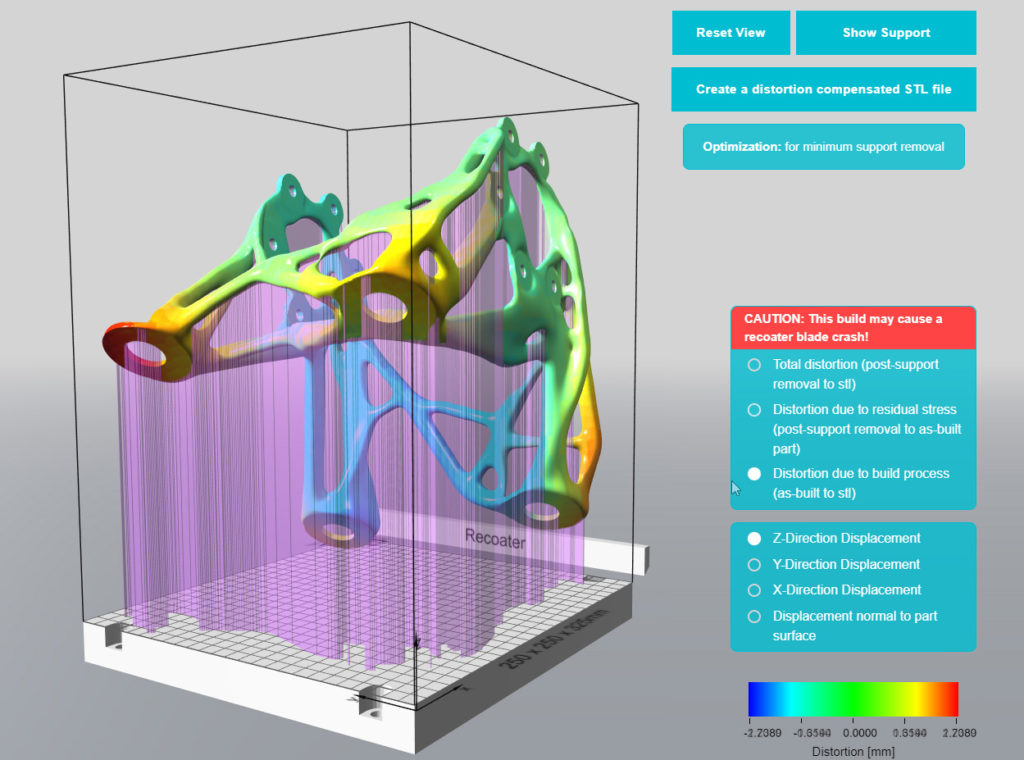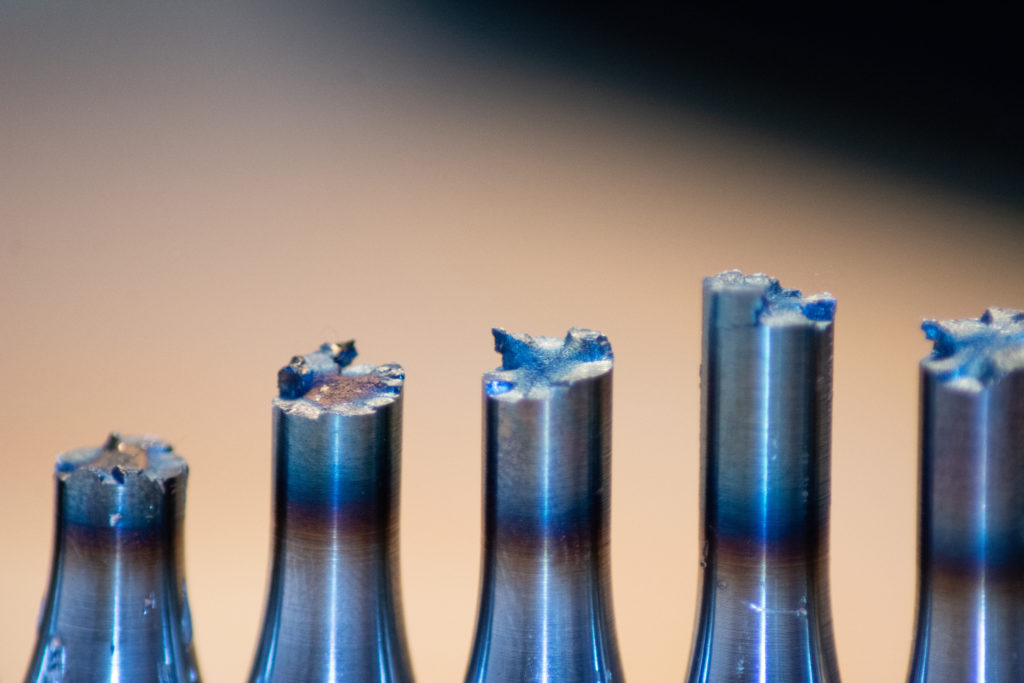The benefits of an additive manufacturing (AM) program are highly compelling –for the creation of highly complex parts, economically manufacturing lot sizes of one, and the near elimination of wasted material. But for many companies today achieving these goals with AM is no small feat, especially without the right design and simulation tools. The complexity and variability of parts is a double-edged sword. Additive allows for production of much more complex geometries, but the wider solution space means there are more possible failure modes compared to the production of simpler geometries using traditional methods. Even the most seasoned experts run the risk of enduring multiple print runs to yield sufficient parts that meet their requirements. This not only undermines AM’s promise of waste reduction, but also multiplies the cost of a project. For additive manufacturing to grow as a viable production technology in an industrial setting, companies will need intelligent tools to help them achieve first article quality from the AM process.
Printing errors directly translate to increased cost and lower yields, which are unwelcome phrases in the world of industrialized manufacturing, and rightfully so. The business model for modern mass production is built around efficiency and quality to maintain profitability and viability. Moving some of the development cycle steps into the virtual world via simulation removes the need for expensive physical testing to certify product quality. For example, a structural member in a vehicle chassis needs to withstand a certain level of stress and fatigue beyond what would reasonably be experienced in normal operation as a safety factor. In the past, the parts would be designed and engineered to meet that goal and then physical prototypes would be tested to ensure meeting the desired results. Today, such parts are simulated in a virtual setting to assess part performance before they are produced.
Simulate for success
By simulating product performance virtually, each test iteration is completed faster and without the wasted material of creating prototypes for physical testing. However, the variety of unknowns in the AM process means many different simulation techniques should be considered before production begins. These techniques include print orientation optimization, print process simulation, and even fatigue and durability simulation.
The right side up
All other variables being equal, one of the fastest paths to improving print quality and performance is selecting the optimal print orientation within the build tray. In planar printing the orientation of a print can drastically impact the necessary print supports needed for overhangs or regions that could sag under gravity while cooling. A clever engineer might design the part to avoid many of these hurdles but would need years of experience to achieve that. However, simulating the impact of a large set of orientations can deliver a perfect part, freeing up engineering time for improving part performance rather than printing adjustments.

Figure 1 – Print orientation simulation
Orientation can also impact the strength of a component while using planar printing methods. If a stress concentrating structure inadvertently aligns with a layer boundary the overall strength can drop precipitously. Again, while this can be considered by an experienced user, simulation reduces the dependance on such highly specific knowledge, enabling more time to be devoted to the performance of the components.
Printing paths
With the traditional, subtractive processes, programming manufacturing operations is critical to the final quality regardless of the manufacturing method being used. Machining requires the right rotational speed for surfacing, jog speed to prevent material stoppage, and the available approach angles for cuts can greatly impact the manufacturable geometries. Additive also requires insights into the printing operations, but for different reasons. Overlapping print layers without proper cooling can cause excessive melting, the patterns used for infill can impact strength unevenly in different directions, and even the use or lack of support structures can impact the final viability of a print.
The greatest difference between traditional manufacturing processes and AM, however, is user experience. Compared to decades of experience in subtractive technologies, additive machine users only have a few years of understanding the impact of specific actions on the part’s final quality. This is only exacerbated by the variety and complexity of printed geometries. That is why so many companies are implementing simulation tools to act as the knowledge intermediary.

Figure 2 – Multi-axis printing can take advantage of gravity rather than accounting for the distortions
Different print simulations allow users to explore a variety of approaches without seriously impacting the final cost of parts. For new users it can be a fantastic training tool to quickly gain knowledge about how different inputs to the printing process can impact the final print. It is also valuable to experienced users as they deepen their knowledge of printing more complex structures or when adopting a new printing technology or material. Instead of having to start from scratch, print simulation provides a ground floor for knowledge.
The usefulness of print simulation is not just confined to planar printing technologies. As more companies adopt advanced printing technologies, like multi-axis and hybrid printing machines, the right simulation tools will provide a smooth transition into quality production as well. Here, the deposition paths might be three-dimensional, and gravity may be used to aid in the printing process. Different simulation techniques are extremely valuable in efficiently achieving first article print quality, regardless of the print technology.
Component fatigue performance
Manufactured components are subjected to a variety of different loading scenarios. Static loading is usually the first type of stress people think about, and for good reason, if a component can’t hold the maximum load without failing, it’s time to go back to the proverbial drawing board. Fortunately for additively manufactured parts, this is a relative non-issue with the use of simulation. An increasing number of AM parts are designed with the help of topology optimization to create an optimized part that can withstand the required stresses.

Figure 3 – Metal samples after failing a stress test
However, one problem that keeps engineers up at night is fatigue performance. Parts may have been qualified for the maximum loading condition, but do they withstand being loaded and unloaded repeatedly?
Industrial adopters of AM are relying on simulation to evaluate the viability of their components over time, instead of printing parts and testing them for long periods using traditional methodologies. The many AM process parameters create local material condition variability in the printed component, leading to localized fatigue properties. That variability makes fatigue analysis very challenging, but novel simulation technologies are overcoming this hurdle. Linking AM process conditions to an accurate fatigue prediction enables an estimated fatigue performance for the 3D printed component. This is extremely important to the end value of additive manufacturing for two reasons. Instead of waiting weeks for parts to complete their testing regimen, results can be delivered in days or even hours. But it also eliminates the requirement of multiple prints for what very well could be a one-of-a-kind component, where any additional prints rapidly increase the overall cost of the part.
Simulation is the key to a fast ramp
Additive manufacturing is an amazing technology, but using it effectively requires understanding the intricacies of this relatively new printing process. Historically, the process of gaining increased knowledge of a manufacturing process has required specialized experience within the field, but the power and ubiquity of simulation is changing that dynamic.
Simulation can act as a training tool for AM, enabling much greater experience in the process with a relatively short time investment. Testing in a virtual space provides engineers, designers, and manufacturers the ability to fail with minimal consequence. Instead of eating through expensive raw materials and wasting valuable production time on a failed print, the main costs of simulation are in computation time. Simulation is becoming increasingly necessary for companies looking to accelerate the success of additive manufacturing for industrial applications.
About the author:
 Ashley Eckhoff (ashley.eckhoff@siemens.com) is an expert in the Additive Manufacturing Program for Siemens Software’s Manufacturing Engineering group. He has a background in engineering and has been with Siemens for over 20 years in various capacities. He has spent several years deep-diving into additive manufacturing in both product design and marketing roles.
Ashley Eckhoff (ashley.eckhoff@siemens.com) is an expert in the Additive Manufacturing Program for Siemens Software’s Manufacturing Engineering group. He has a background in engineering and has been with Siemens for over 20 years in various capacities. He has spent several years deep-diving into additive manufacturing in both product design and marketing roles.
Subscribe to Our Email Newsletter
Stay up-to-date on all the latest news from the 3D printing industry and receive information and offers from third party vendors.
You May Also Like
Further Understanding of 3D Printing Design at ADDITIV Design World
ADDITIV is back once again! This time, the virtual platform for additive manufacturing will be holding the first-ever edition of ADDITIV Design World on May 23rd from 9:00 AM –...
3D Printer Maker EVO-tech Reborn as NEVO3D — Once More With Feeling
EVO-tech was a 3D printing service and original equipment manufacturer established in 2013 and based in Schörfling am Attersee, Austria. The company produced high-quality material extrusion systems featuring linear bearings,...
3D Systems Brings 3D Printed PEEK Cranial Implant to the U.S. with FDA Clearance
For more than 10 years, 3D Systems (NYSE:DDD) has worked hand-in-hand with surgeons to plan over 150,000 patient-specific cases, and develop more than two million instruments and implants from its...
CDFAM Returns to Berlin for Second Annual Symposium
The second CDFAM Computational Design Symposium is scheduled for May 7-8, 2024, in Berlin, and will convene leading experts in computational design across all scales. Building upon the first event...































